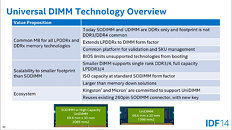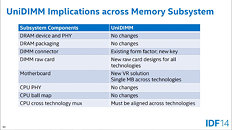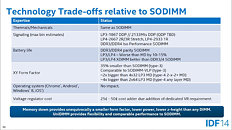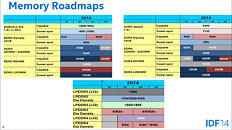Sunday, September 14th 2014

How Intel Plans to Transition Between DDR3 and DDR4 for the Mainstream
The transition between DDR2 and DDR3 system memory types was slower than the one between DDR and DDR2. DDR3 made its mainstream debut with Intel's X38 and P35 Express platforms, at a time when the memory controller was still within the domain of a motherboard chipset, at least in Intel's case. The P35 supported both DDR2 and DDR3 memory types, and motherboard manufacturers made high-end products based on each of the two memory types, with some even supporting both.
Higher module prices posed a real, and higher latencies, posed a less real set of drawbacks to the initial adoption of DDR3. Those, coupled with the limited system bus bandwidth, to take advantage of DDR3. DDR3 only really took off with Nehalem, Intel's first processor with an integrated memory controller (IMC). An IMC, again in Intel's case, meant that the CPU came with memory I/O pins, and could only support one memory type - DDR3. Since then, DDR3 proliferated to the mainstream. Will the story repeat itself during the transition between DDR3 and the new DDR4 memory introduced alongside Intel's Core i7 "Haswell-E" HEDT platform? Not exactly.Intel wants to make real sure that the swelling inventories of DDR3 memory modules are sufficiently digested by the market (sold out), before imposing DDR4 onto the mainstream. Hence the memory made its grand client entrance with Core i7 "Haswell-E," a family of processors that starts at $390, going all the way up to $1000. The target audience of these chips won't mind spending the extra dime on cutting-edge technologies, including memory. "Haswell-E" features a 256-bit wide DDR4 IMC, which at JEDEC standard speeds of DDR4-2133 MHz, can bathe the processor's 6-8 cores in 68 GB/s of memory bandwidth, right off the bat. DDR4 brings energy efficiency to the table. DDR4-2133 MHz modules ship with rated voltage as low as 1.2V, compared to the 1.8V DDR3 debuted with, before dropping to 1.65V on Nehalem, and 1.5V on SandyBridge. These drops in module voltages were made possible with DRAM manufacturers shrinking their fab process nodes.
Intel's bright idea about transitioning between DDR3 and DDR4 for mainstream client platforms is not hugely different from how its P35 Express chipset dealt with the issue. It plans to come up with a new memory module form-factor, called UniDIMM. It's a DIMM that can hold both DDR3-class and DDR4-class DRAM chips, designed for Intel's upcoming Core "Skylake" processors. "Skylake" will feature an IMC that supports both DDR3 and DDR4. With UniDIMM at their disposal, system manufacturers can source UniDIMM modules with DDR3 DRAM chips (which will be cheap, until DDR3 inventories begin drying up), and offer upgrade potential to UniDIMMs with DDR4 chips (which will get progressively cheaper). Future notebooks that ship with DDR4-UniDIMM memory will still support older DDR3-UniDIMM.
Capiche? No? UniDIMM is a standardized module design, with its key cutout notch at a certain point. Measuring 69.6 mm x 20 mm, it's as wide, but shorter than an SO-DIMM. There will be two kinds of UniDIMMs, DDR3 UniDIMM and DDR4 UniDIMM, both having 260 pins, the same key position (but one that's different from DDR3 SO-DIMM), and hence work on a platform that supports both standards, "Skylake," in this case. The module will be designed to support both standard- and LP- DDR3 and DDR4 DRAM chips.
DDR3/LPDDR3 UniDIMMs will ship with frequencies of 1866 MHz (DDR) as standard. DDR4/LPDDR4 ones will start at 2666 MHz (Skylake's standard DDR4 memory clock speed, double that of DDR3-1333, which was Lynnfield's standard). There will be higher-tier standardized clocks, such as 2133 MHz for DDR3/LPDDR3, and 2933 MHz for DDR4/LPDDR4. Since UniDIMM is more of Intel's pet-project than that of JEDEC, it gets to announce which memory module makers have expressed interest in it - Kingston and Micron (makers of Crucial) have expressed commitment to it.
"Skylake" Core processors come out in 2015. That's going to be when DDR4 enters mainstream client platforms.
Higher module prices posed a real, and higher latencies, posed a less real set of drawbacks to the initial adoption of DDR3. Those, coupled with the limited system bus bandwidth, to take advantage of DDR3. DDR3 only really took off with Nehalem, Intel's first processor with an integrated memory controller (IMC). An IMC, again in Intel's case, meant that the CPU came with memory I/O pins, and could only support one memory type - DDR3. Since then, DDR3 proliferated to the mainstream. Will the story repeat itself during the transition between DDR3 and the new DDR4 memory introduced alongside Intel's Core i7 "Haswell-E" HEDT platform? Not exactly.Intel wants to make real sure that the swelling inventories of DDR3 memory modules are sufficiently digested by the market (sold out), before imposing DDR4 onto the mainstream. Hence the memory made its grand client entrance with Core i7 "Haswell-E," a family of processors that starts at $390, going all the way up to $1000. The target audience of these chips won't mind spending the extra dime on cutting-edge technologies, including memory. "Haswell-E" features a 256-bit wide DDR4 IMC, which at JEDEC standard speeds of DDR4-2133 MHz, can bathe the processor's 6-8 cores in 68 GB/s of memory bandwidth, right off the bat. DDR4 brings energy efficiency to the table. DDR4-2133 MHz modules ship with rated voltage as low as 1.2V, compared to the 1.8V DDR3 debuted with, before dropping to 1.65V on Nehalem, and 1.5V on SandyBridge. These drops in module voltages were made possible with DRAM manufacturers shrinking their fab process nodes.
Intel's bright idea about transitioning between DDR3 and DDR4 for mainstream client platforms is not hugely different from how its P35 Express chipset dealt with the issue. It plans to come up with a new memory module form-factor, called UniDIMM. It's a DIMM that can hold both DDR3-class and DDR4-class DRAM chips, designed for Intel's upcoming Core "Skylake" processors. "Skylake" will feature an IMC that supports both DDR3 and DDR4. With UniDIMM at their disposal, system manufacturers can source UniDIMM modules with DDR3 DRAM chips (which will be cheap, until DDR3 inventories begin drying up), and offer upgrade potential to UniDIMMs with DDR4 chips (which will get progressively cheaper). Future notebooks that ship with DDR4-UniDIMM memory will still support older DDR3-UniDIMM.
Capiche? No? UniDIMM is a standardized module design, with its key cutout notch at a certain point. Measuring 69.6 mm x 20 mm, it's as wide, but shorter than an SO-DIMM. There will be two kinds of UniDIMMs, DDR3 UniDIMM and DDR4 UniDIMM, both having 260 pins, the same key position (but one that's different from DDR3 SO-DIMM), and hence work on a platform that supports both standards, "Skylake," in this case. The module will be designed to support both standard- and LP- DDR3 and DDR4 DRAM chips.
DDR3/LPDDR3 UniDIMMs will ship with frequencies of 1866 MHz (DDR) as standard. DDR4/LPDDR4 ones will start at 2666 MHz (Skylake's standard DDR4 memory clock speed, double that of DDR3-1333, which was Lynnfield's standard). There will be higher-tier standardized clocks, such as 2133 MHz for DDR3/LPDDR3, and 2933 MHz for DDR4/LPDDR4. Since UniDIMM is more of Intel's pet-project than that of JEDEC, it gets to announce which memory module makers have expressed interest in it - Kingston and Micron (makers of Crucial) have expressed commitment to it.
"Skylake" Core processors come out in 2015. That's going to be when DDR4 enters mainstream client platforms.




25 Comments on How Intel Plans to Transition Between DDR3 and DDR4 for the Mainstream
Their ideas on UniDIMM seems a bit retarded though, 1866 for DDR3 as default? Seems like a good way to get stuck with platform specific hardware much like RAMbus. How about giving us a riser card that fits a DDR4 slot that adapts to DDR3, or a board with both slots but only two of each? But that might be too simple, sounds like a dick move to force people who adopt to stay with their proprietary hardware or pay the price.
That's utterly retarded.
Why not just stick with the standards and do what worked with 775 and AM3, let the board makers pick the RAM that will be used. Lower end boards will use DDR3 and high end boards will use DDR4. Since low to mid-range boards sell vastly higher quantities than the high-end boards, DDR3 will stay in demand to dry up the stock, then when the DDR3 supply is drying up board manufacturers can switch entirely to DDR4.
It's easy to see that Intel pretty much controls the market and evolution of tech. when you see this!
To be honest, I don't like the idea. But I see their motivation and understand it.That's the way I take it as. It allows DDR3 and DDR4 chips to be used on proprietary sticks. It smells of FB-DIMM (let's do something crazy for the sake of...something).
I presume post Skylake will have the same DDR4 standard X99 is using now. The reason why they are going back to the industry standard will be because it supports higher densities per stick.
Bring back the CPU upgrade boards as well and I'll be in heaven.
As a consumer I'd much rather they went with a different approach, like say giving people a big enough performance improvement to warrant switching platforms. Comparing where we are now to Sandy core for core it feels like we've just been inching along.
Intel business relationship >>>>>> consumer
For the people who build their own systems, it doesn't sound like there is any reason not to expect that motherboard manufacturers will focus upon LGA1151 boards with conventional DDR3 and/or DDR4 DIMM slots. For the build-your-own market, UniDIMM seems like it will at best be a niche.
Did i get it right?
But still, wtf?Ah... if it turns out this way it would actually make sense.
www.geek.com/chips/intel-motherboard-mess-564785/
OEMs like Dell will choose UniDIMM motherboards as it gives them the most flexibility in memory options. End users like you and me buying our own motherboards will choose ones with conventional DIMM slots since the DIMMs will be cheaper and either backwards compatible (DDR3-DIMM) or faster and more future proof (DDR4-DIMM).UniDIMMs aren't intended for BGA chips, as they're likely to be the ones that have the memory soldered to the motherboard anyway. Most likely you'll see UniDIMM in desktop PCs from OEMs only where changing out the DIMM based on available supply is desirable and the extra power consumption of DDR3 isn't an issue. You won't see them in laptops because they will switch to DDR4 immediately due to the power savings even if the memory chips are more expensive.